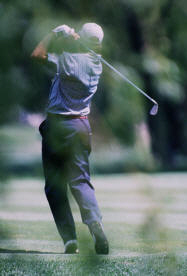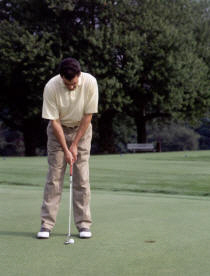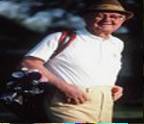Most of us have heard of “algorithms”, but a brief review may be in order. Clearly, they have nothing to do with Al Gore, even though he claims to have invented the Internet, radio waves, and magnetism. An “algorithm” may be defined as a specific set of instructions for carrying out a procedure or solving a problem. For example, a recipe for baking a cake is an algorithm in that it contains a list of ingredients (“variables”) and a list of directions (“statements”). The statements explain what to do with the variables. A misprint in any of the statements, or the failure to follow any of the statements will result in a bad cake. Likewise, the instructions for building a model airplane are an algorithm.
Algorithms are used in various aspects of modern-day golf. For example, golf performance monitors are based on mathematical algorithms that produce information about your swing, including head speed, launch angle, ball spin, ball velocity, etc. Golf course ranging and direction-finding systems may make use of geometric location algorithms. And, just like a recipe, your favorite pro’s nine-step approach to a successful drive, is an algorithm.
I am not interested in competing algorithms related to the swing of a specific club, algorithms which differ from one another based upon the success that different instructors have had with different techniques. For example, in the July 2006 issue of Golf Magazine, Pro Todd Anderson stresses the need to “sweep” the clubhead of the fairway wood along the ground to create extension in the backswing (pg. 51), while Jason Zuback claims (pg. 136) that he doesn’t “have any swing keys to start [his] takeaway.” I define these algorithms as “Lower-Order Algorithms” because they are based on techniques which work for some players, but not for other players.
I am interested in discovering what I refer to as fundamental or “Higher-Order Algorithms” – that is, golf algorithms which address the basic building blocks of a swing. I submit that if such algorithms exist, and if the statements contained in them are meaningful and followed, they should (a) result in better swings and (b) facilitate the implementation of player-specific Lower-Order Algorithms.
In Articles 4 and 5, I attempted to set forth a Higher-Order Algorithm when I discussed Caddyus’ formula E = MC: that is, the Energy needed for powerful drives and fairway shots, is a function of (self-generated) Motion and (inner) Confidence. Based upon Second Century understandings of motion, Caddyus taught us that the amount of transmitted motion (that is, Energy) from the end of the staff (clubhead) to the rock (ball) depended upon the integration of the shepherd’s self-generated motion and inner confidence. The amount of energy transmitted to the ball is greater to the extent that there is a greater integration of self-generated motion and inner confidence. At the time Caddyus wrote, self-generated motion in swinging the staff was considered to be an innate, uncomplicated athletic ability. This all sounds simple, but the implications are significant in that we have been given ancient insights into the importance of reliance on innate athletic ability and inner confidence.
Once we accept fully the idea that we possess an inherited, innate athletic ability to swing a club (just as our ancient ancestors swung clubs), and once we embrace the invitation to bring forth our inner confidence, we can then experiment with Lower-Order Algorithms to tweak - but not distort - our swings. And, please remember that Caddyus instructed us that any such “tweaking” should be imparted by a qualified Teacher (that is, a golf professional).
In Article 5, I suggested that the algorithm E = MC may be applicable to putting, in that some mid-body motion may be helpful in the execution of the putt. I am attempting to discover whether other golf algorithms may be found in the Golfnostic Gospels and / or in the research papers in the archives of the PCT Institute in the former Soviet Union. I promise to keep my readers apprised of my progress.
Jack Long is a golf-theorist and founder of The Paranormal Golf Institute. He is working on a series of articles based in part upon:
Cold War research documents in the field of paranormally controlled trajectories (PCT), documents recently discovered in the archives of the PCT Institute in Niblickvostock in the former Soviet Union; and
His own, and other recent translations of the Golfnostic Gospels unearthed last year in caves near the northern Egyptian city of El Sandtrapya.
No part of this article may be used or reproduced in any manner whatsoever without written permission from Jack Long, PGI, 192 College Street, Burlington, VT 05401.
You can read more about Jacks theory on golf at these links.
Jack
Long 2
Jack Long 3
Jack Long 4
Jack Long 5
Jack Long 6
Jack Long 7
Jack Long 8
Jack Long 9
Jack Long 10
Jack Long 11
Jack Long 12















































